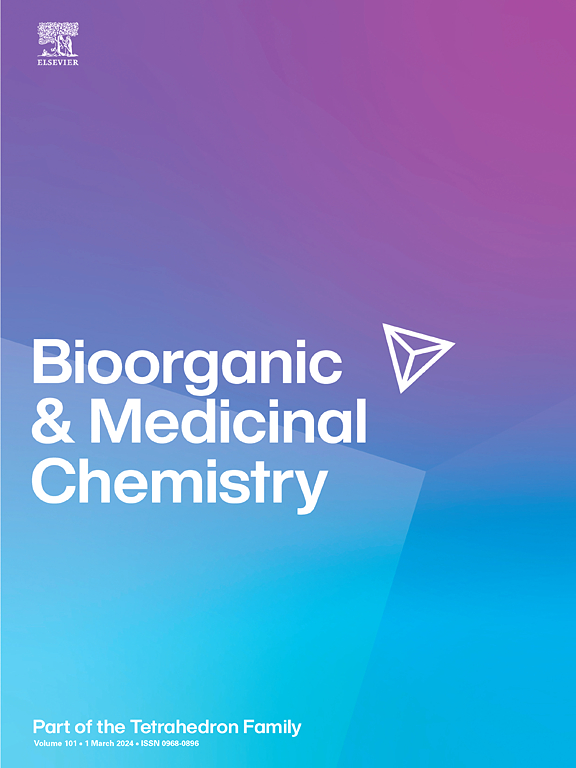Design, synthesis and biological evaluation of 3-arylisoquinoline derivatives as topoisomerase IIα inhibitors for the therapy of small cell lung cancer
IF 3
3区 医学
Q2 BIOCHEMISTRY & MOLECULAR BIOLOGY
引用次数: 0
Abstract
There is a pressing need to search for efficient therapeutic molecular candidates for the treatment of small cell lung cancer (SCLC). Here, we designed a series of 3-arylisoquinoline derivatives by introducing either flexible tertiary amino groups or rigid imidazole rings, aiming to enhance anti-SCCL efficay. Among them, compound 52 with a symmetrical dibutylamine side chain demonstrated a remarkable inhibitory potency on Topoismerase II (Topo II). In vitro studies revealed that 52 exhibited superior inhibitory activity to etoposide against SCLC cells (IC50 = 0.6 μM in NCI-H446 cells and 0.1 μM in NCI-H1048 cells). Molecular docking studies indicated that 52 could intercalate into DNA strands. Comet assays accordingly confirmed it induced DNA damage, which subsequently triggered intrinsic mitochondrial apoptosis. Moreover, 52 effectively attenuated the phosphorylation of the PI3K/Akt/mTOR signaling pathway, which in turn effectively suppressed proliferation, invasion, and migration of SCLC cells. In the NCI-H446 cell-derived xenograft (CDX) model, 52 demonstrated a significant tumor inhibition effect. At a low dose of 2.5 mg/kg, the tumor inhibition rate was 71.58 %, and at a high dose of 5 mg/kg, it reached 88.16 %. In contrast, the positive control etoposide, at a dose of 5 mg/kg, only showed a tumor inhibition rate of 41.77 %, highlighting the superiority of 52. In addition, 52 exhibited a better safety profile in the tested mice. Overall, this study lays a solid foundation for the development of 3-arylisoquinoline compounds as potential anti-SCLC agents.

3-芳基异喹啉衍生物拓扑异构酶IIα抑制剂治疗小细胞肺癌的设计、合成及生物学评价
目前迫切需要寻找有效的治疗小细胞肺癌(SCLC)的候选分子。本研究通过引入柔性叔氨基或刚性咪唑环,设计了一系列3-芳基异喹啉衍生物,旨在提高抗sccl的有效性。其中,具有对称二丁胺侧链的化合物52对拓扑异构酶II (Topo II)具有显著的抑制作用。体外实验表明,52对SCLC细胞具有较强的抑制活性(NCI-H446和NCI-H1048细胞的IC50分别为0.6 μM和0.1 μM)。分子对接研究表明,52可以嵌入DNA链。彗星实验证实了它诱导DNA损伤,随后引发线粒体凋亡。此外,52有效地减弱了PI3K/Akt/mTOR信号通路的磷酸化,从而有效地抑制SCLC细胞的增殖、侵袭和迁移。在NCI-H446细胞来源的异种移植物(CDX)模型中,52显示出明显的肿瘤抑制作用。低剂量为2.5 mg/kg时,肿瘤抑制率为71.58%,高剂量为5 mg/kg时,肿瘤抑制率达到88.16%。而阳性对照依托泊苷在剂量为5 mg/kg时,肿瘤抑制率仅为41.77%,突出了52的优越性。此外,52种在实验小鼠中表现出更好的安全性。总之,本研究为开发3-芳基异喹啉类化合物作为潜在的抗sclc药物奠定了坚实的基础。
本文章由计算机程序翻译,如有差异,请以英文原文为准。
求助全文
约1分钟内获得全文
求助全文
来源期刊

Bioorganic & Medicinal Chemistry
医学-生化与分子生物学
CiteScore
6.80
自引率
2.90%
发文量
413
审稿时长
17 days
期刊介绍:
Bioorganic & Medicinal Chemistry provides an international forum for the publication of full original research papers and critical reviews on molecular interactions in key biological targets such as receptors, channels, enzymes, nucleotides, lipids and saccharides.
The aim of the journal is to promote a better understanding at the molecular level of life processes, and living organisms, as well as the interaction of these with chemical agents. A special feature will be that colour illustrations will be reproduced at no charge to the author, provided that the Editor agrees that colour is essential to the information content of the illustration in question.
 求助内容:
求助内容: 应助结果提醒方式:
应助结果提醒方式:


